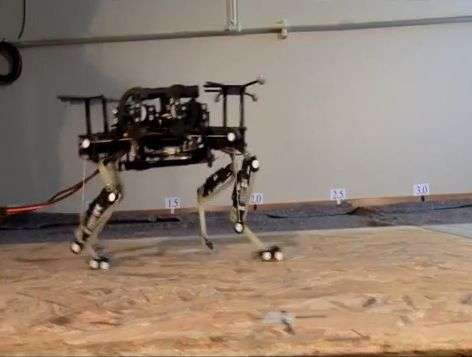May 1, 2013 report
Researchers use gait primitives from real animals to simulate movement in robots (w/ video)

(Phys.org) —Researchers at the Italian Institute of Technology (IIT) have used stop-motion technology to capture gait primitives of real animals—the data captured was then used to allow a small quadruped robot to walk and trot like a real horse. The team describes their project in their paper published in Biological Cybernetics.
The robot used by the team at IIT is known as cheetah-cub, it was developed jointly between IIT and a team in Switzerland at Ecole Polytechnique Federale de Lausanne. Its purpose is to gain knowledge of how to get robot animals to move like real animals. In its original incarnation, the robot was made to move as closely as possible to a cheetah, hence its name. In this new effort, the team from IIT worked to cause the robot—which is roughly the size of a housecat—to walk, trot and run like a horse.
To make that happen, the team is pioneering a measuring technique that uses what are known as Kinematic Motion Primitives (kMPs). It involves employing stop-motion video capture to discover "primitives" in an animal's gait. Primitives describe where all the animals limbs are, the angles of their joints, etc. at certain points in time while the animal is walking, running, etc. Researchers have found that the gait of an animals is cyclic, thus, to recreate the process all roboticists need do is capture the essential components of the gait, and run it like a loop, over and over—except that in the real world, external events intervene to compromise the gait—uneven terrain, potholes, etc.—causing a need for constant readjustment to keep the gait going. To get that to happen with a robot, engineers have designed what are known as Central Pattern Generators—neural networks that use sensors in the legs to note disruptions to the gait, and then to get the robot back on track again as quickly and smoothly as possible.
Using this technique the team at IIT has caused the robot to walk in a way that resembles the way a horse walks, at roughly 0.43 m/s and to trot at approximately 0.59 m/s. Running, or in this case galloping has not gone as well, as the robot has a stiff spine—horses flex their spines when running. The team has also added in transitional programming to allow the robot to move seamlessly between walking and trotting and is currently researching ways to give the robot a flexible spine.
More information: Horse-like walking, trotting, and galloping derived from kinematic Motion Primitives (kMPs) and their application to walk/trot transitions in a compliant quadruped robot, Biological Cybernetics, March 2013. DOI:10.1007/s00422-013-0551-9 . link.springer.com/article/10.1007%2Fs00422-013-0551-9
Abstract
This manuscript proposes a method to directly transfer the features of horse walking, trotting, and galloping to a quadruped robot, with the aim of creating a much more natural (horse-like) locomotion profile. A principal component analysis on horse joint trajectories shows that walk, trot, and gallop can be described by a set of four kinematic Motion Primitives (kMPs). These kMPs are used to generate valid, stable gaits that are tested on a compliant quadruped robot. Tests on the effects of gait frequency scaling as follows: results indicate a speed optimal walking frequency around 3.4 Hz, and an optimal trotting frequency around 4 Hz. Following, a criterion to synthesize gait transitions is proposed, and the walk/trot transitions are successfully tested on the robot. The performance of the robot when the transitions are scaled in frequency is evaluated by means of roll and pitch angle phase plots.
via IEEE Spectrum
© 2013 Phys.org




















